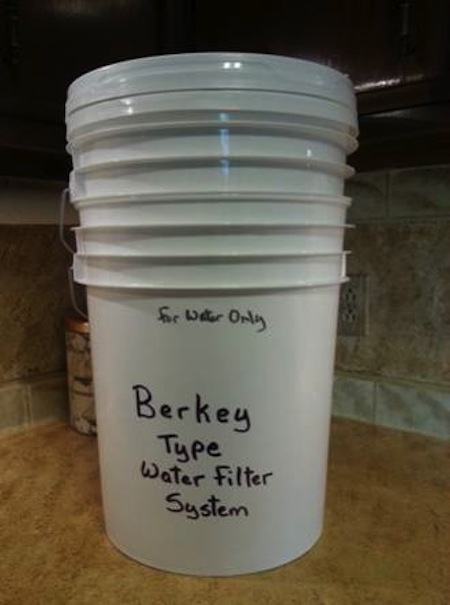
*About Water Filters/Filtering*
By: TooshieGalore
18 September 2015
If you can swing it, whole-house water-filtering is best but if you're considering something less than a whole-house system, then two name-brand options to consider are Berkey and Sawyer. I have both and use both. In the photos below, the white buckets are my Berkey system and blue buckets are the Sawyer system. But first, a little background info is necessary….
Water filtering is all about getting the bad stuff out. Therefore the smaller the holes in the filter, the better job it does – but, the slower the flow rate, as it takes longer for water particles to pass thru very small holes; and, those very small holes are easier to clog. Water filter holes are rated in microns. 1 micron is equal to 1 millionth of a meter. The smaller the micron number, the finer the filtration. Filters range from 40 microns to .01. You need 1 micron or smaller to remove most waterborne bacteria and parasites. A 0.5 micron filter will remove even more. There are "absolute" and "nominal" filters. An "absolute" filter is best. Filters are made using different types of materials. Each has its benefits and drawbacks.
Using a pre-filter to remove sediment from water will greatly extend the life of your "good" filter. Save old T-shirts and cotton bed sheets. They make a great pre-filter. I cut pre-filters large enough to cover the mouth of a 5-gallon bucket and still have three inches or so remaining around the rim. I cut a 6" hole from the center of a bucket-lid. Then, stretch the pre-filter material over the 5-gallon bucket and fasten the holely-lid on top. This holds the pre-filter in place while I pour water over it – otherwise it's is a two person job. Change the pre-filter often.
I clean the "good" filter by back-flowing clean water with a syringe after every 100 gallons or so of use. When you buy your filter it normally will come with instructions on how to do this.
Have a few. You need at least two to transport, store or pre-filter "dirty water". You need one as a container for the water being filtered plus you need at least one to transport or store "clean water". Plus, I like to have an extra, so that's a total of five buckets. Label each bucket so the clean water bucket doesn't become contaminated with dirty water. I also label "For Water Only" to make sure that water buckets don't get used for Hubby's oily garage projects. I write instructions right on the bucket so I don't forget my methods.

Prepare buckets in advance. You'll need to drill holes and insert fittings. You could also drill a hole for a water spigot into the clean water bucket to make it easier and more sanitary to dispense potable water. In other words, get it all set up before you need it.
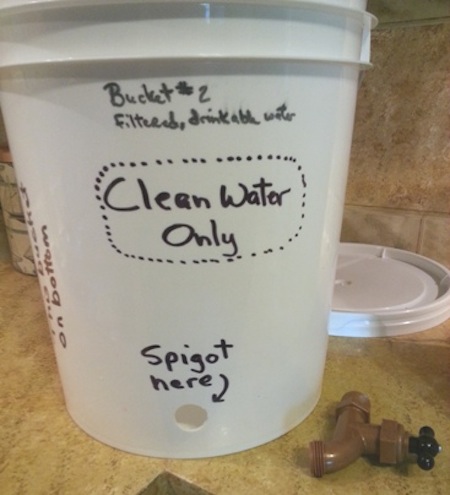
You'll want a lid for each clean water bucket to protect potable water from flies, mosquitoes and debris. Don't forget an extra lid for the holey-pre-filter.
Berkey is a manufacture with an excellent reputation because they work. Made of shiny stainless steel, they look beautiful sitting on the kitchen counter - but they are not cheap. You can have the great Berkey filter at half the cost by installing Berkey replacement filters into a 5-gallon plastic bucket. I recommend installing two Berkey filters in a bucket for faster potable water – that will give you a flow of 2-3 gallons per hour. . Berkey does not publish a micron rating and they say the filter has a life of 6,000 gallons. These filters need to be primed for long term storage. Read all about Berkey filters at http://http://www.bigberkeywaterfilters.com/. Watch the video I used to learn to DIY a Berkey Plastic Bucket system here: https://www.youtube.com/watch?v=XYG_TLoI9O4
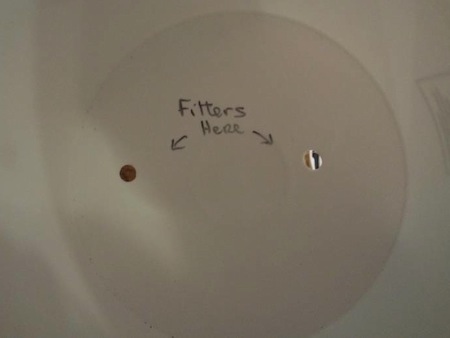
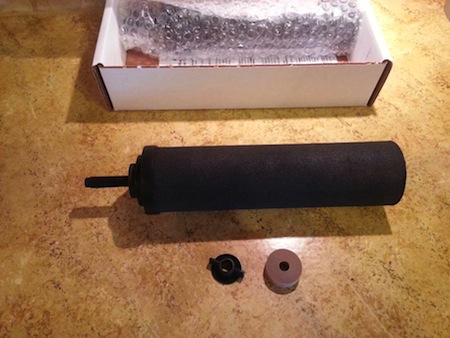
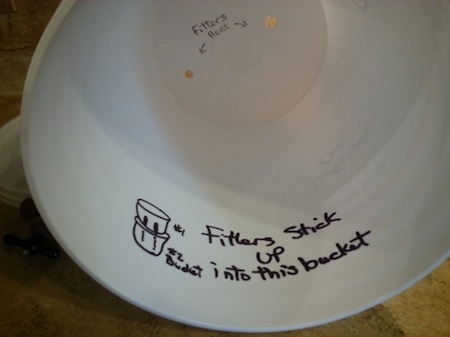
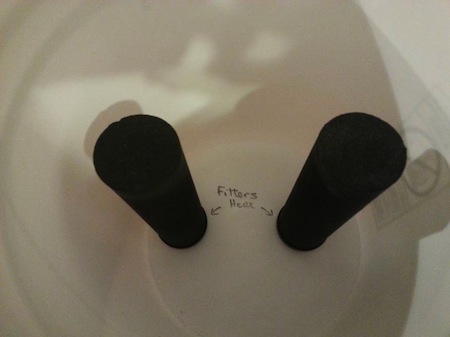
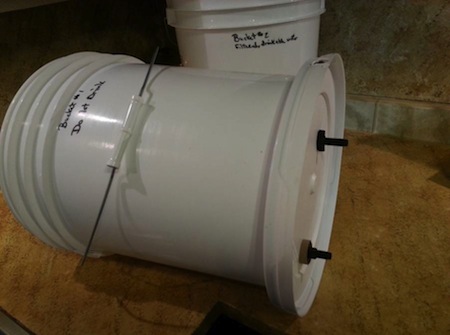
Sawyer manufactures several different types and sizes of systems but they all use a proprietary hollow-fiber membrane. I like the Sawyer Point Zero Two for at-home filtering. It's an absolute 0.02 filter and costs about $125. Although their advertising says it will filter 600 liters (150 gallons) per day, that's just advertising. Plan to get a flow of 2 to 3 gallons per hour. This is a simple system and the filter should be good for 1,000,000 gallons (if water is pre-filtered and the filter is regularly cleaned).
Your family won't intuitively know how to assemble the system and if it's been a while since last used, you will forget. While fresh in your mind, take photos and write an SOP for assembly and use. You can laminate paper instructions or write on the bucket:
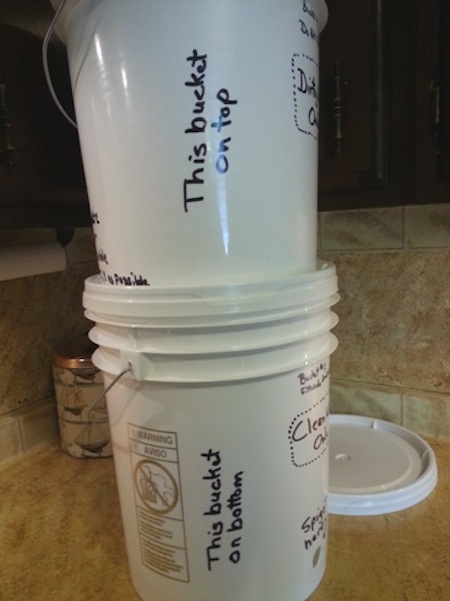
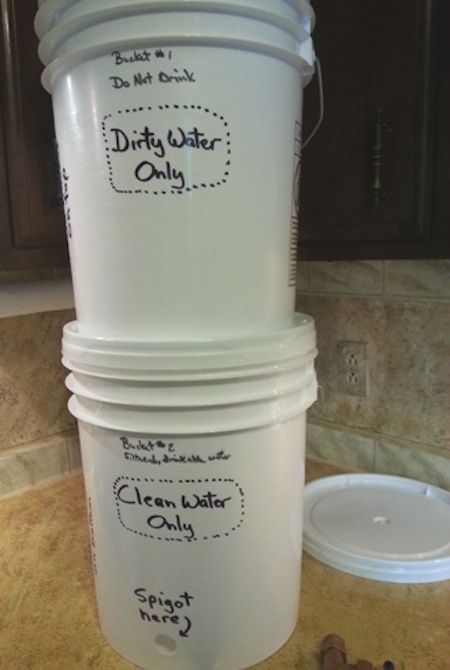
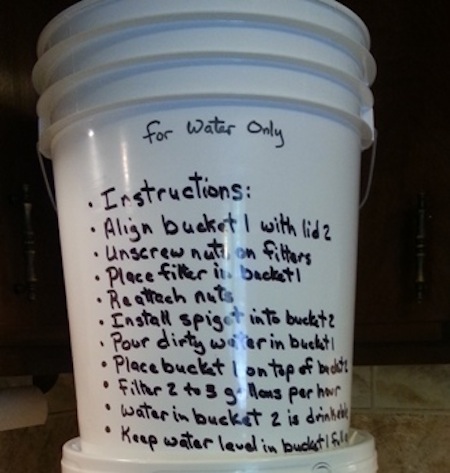
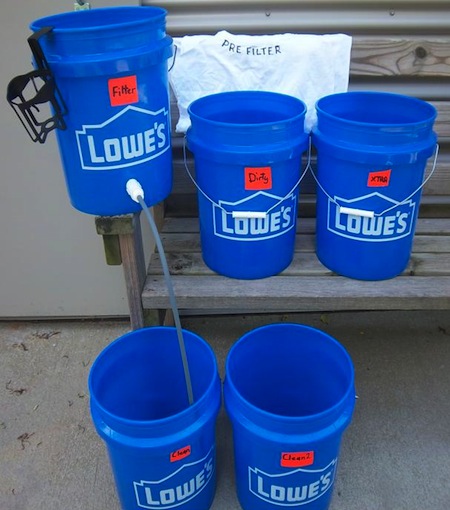
Organize all your water purification together for ease of finding.
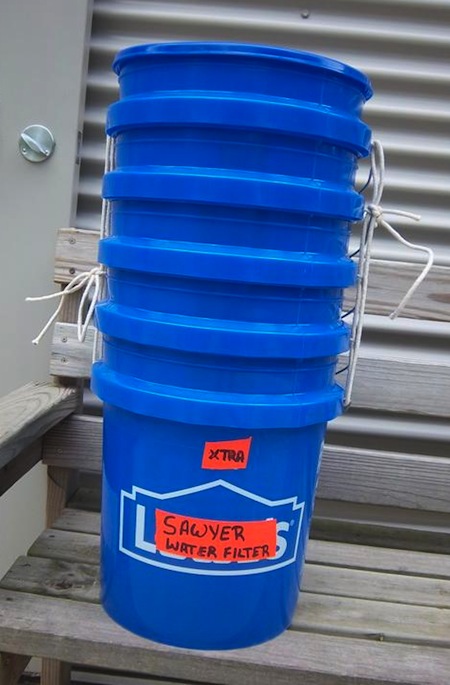
Berkey filter replacements:http://www.amazon.com/Berkey-Replacement-Purification-Elements-2-Pack/dp/B00BWIWW1Y/ref=sr_1_6?ie=UTF8&qid=1431624753&sr=8-6&keywords=berkey+water+filter
Water dispenser faucet:http://www.amazon.com/Water-Dispenser-Replacement-Faucet-White/dp/B000BARBGK/ref=sr_1_1?ie=UTF8&qid=1431714914&sr=8-1&keywords=plastic+spigot
Sawyer Filter Kit: This kit comes with everything you need including a cleaning syringe and the paddle bit to drill the proper size hole in your bucket. http://www.amazon.com/Sawyer-Products-SP191-Purifier-Assembly/dp/B0051HHNJ8/ref=sr_1_1?ie=UTF8&qid=1431625176&sr=8-1&keywords=sawyer+zero+point+two
TooshieGalore
www.alpharubicon.com
All materials at this site not otherwise credited are Copyright © 1996 - 2015 Trip Williams. All rights reserved. May be reproduced for personal use only. Use of any material contained herein is subject to stated terms or written permission.